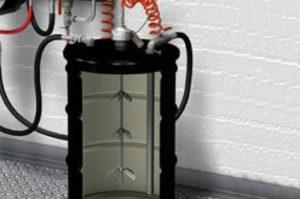 The proper mixing of polyurethane or polyurea coatings is one of the most important aspects of applying a fast set coating and insuring a quality coating with long lasting performance.
The proper mixing of polyurethane or polyurea coatings is one of the most important aspects of applying a fast set coating and insuring a quality coating with long lasting performance.
Generally the resin or B side of the system is the only drum that will require mixing, though you should check the systems data sheet as some materials do require mixing of the Iso or A side. There are several components that are susceptible to settling in the resin, these include pigments, molecular sieve, and catalysts.
If you do not mix the material and any of these components have settled, you may still achieve the proper 1:1 volume thru the spray equipment but the mix will not be right. Transfer pumps pull material from the bottom of the drum and the increased levels of pigments, molecular sieve, and catalysts will displace the reactive resin and you will be spraying OFF RATIO.
This could cause a variety of problems: foaming, blister formation in the coating system, poor spray pattern, color variances and poor coating performance.
It is recommended that the following procedure be used:
Drums must be mixed at high speeds (to lift the heavy components off the bottom of the drum) for a period of at least 1/2 hour before use.
It is good practice to leave the mixer on at low speed during spraying.
The mixing shaft should have a minimum of one 8 inch collapsible blade (located at the bottom of the drum) and two 5-6 inch blades (one located in the middle and one close to the top of the drum). This will provide the proper agitation and mix within a standard 55 gallon drum as 8 inches is 1/3 the diameter of the drum.
It should be noted that auger type mixers may not properly pull up and mix the material in the drums.
By following these few simple recommendations you can save yourself many headaches including unhappy customers and callbacks due to poor coating performance.

